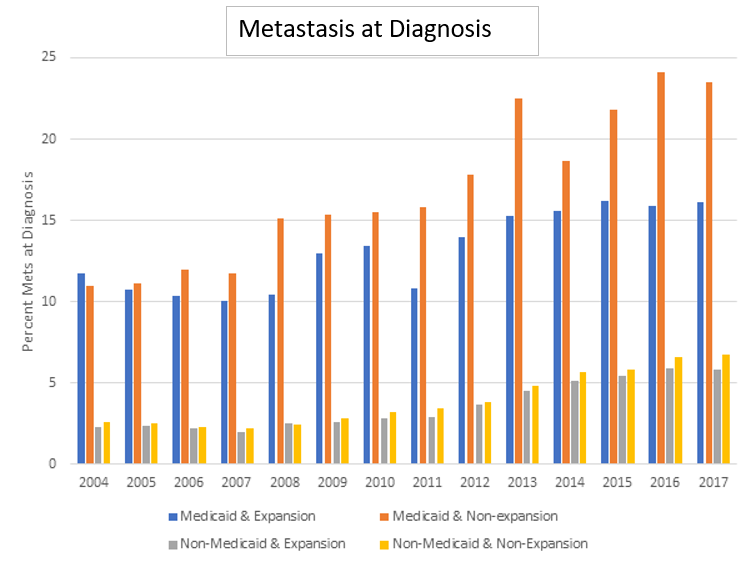Back
Poster, Podium & Video Sessions
Podium
PD03: Prostate Cancer: Epidemiology & Natural History I
PD03-08: The Impact of Medicaid Expansion on Insurance Coverage and Metastatic Disease at Diagnosis in Prostate Cancer Patients
Friday, May 13, 2022
8:10 AM – 8:20 AM
Location: Room 245
David Schroeder*, Solange Bassale, Brian Duty, Ryan Kopp, Portland, OR
- DS
Podium Presenter(s)
Introduction: In prostate cancer, improved access to preventative and diagnostic services following the Affordable Care Act’s expansion of Medicaid may have profound effects on disease course and outcomes. We hypothesized that states which enacted Medicaid expansion experienced greater Medicaid coverage gains and lower rates of metastatic disease at time of detection.
Methods: We performed a cross-sectional analysis of 754,952 non-elderly patients aged 40-64 diagnosed with prostate cancer from 2004-2017 using the National Cancer Database (NCDB). Descriptive statistics were generated for demographic variables. Patients were divided into four groups based on diagnosis date (pre-expansion years [2004-2013] vs post-expansion years [2014-2017]) and state expansion status (expansion state [ES] vs. non-expansion state [NES]). For each time period, a multivariate logistic regression was performed to determine the impact of expansion status and other demographic variables on Medicaid enrollment. Metastatic disease at diagnosis was analyzed via multivariate logistic regression with Medicaid and expansion status, time period, and demographic variables as covariates.
Results: In pre-expansion years, the rates of Medicaid patients in ES vs NES was 3.6% vs 2.6%. In post-expansion years, the ES vs NES rates were 8.6% vs 3.8%. Residence in an expansion state, race, ethnicity, income, education, and degree of comorbidity were significantly associated with being enrolled in Medicaid in both periods. The odds of being enrolled in Medicaid in black vs white patients was 3.10 (95% CI 2.99-3.21) in pre-expansion years. It decreased following expansion to 2.63, 95% CI 2.52-2.74. The odds of metastatic prostate cancer diagnosis in Medicaid patients residing in ES vs Non-Medicaid patients residing in NES were 3.04, 95% CI 2.91 – 3.17, P < .0001; for Medicaid NES vs Non-Medicaid NES OR was 4.20, 95% CI 3.95 – 4.47, P < .0001.
Conclusions: We demonstrated that Medicaid expansion led to measurable coverage gains through Medicaid for prostate cancer patients and that these patients had lower odds of metastatic disease at diagnosis.
Source of Funding: No funding.

Methods: We performed a cross-sectional analysis of 754,952 non-elderly patients aged 40-64 diagnosed with prostate cancer from 2004-2017 using the National Cancer Database (NCDB). Descriptive statistics were generated for demographic variables. Patients were divided into four groups based on diagnosis date (pre-expansion years [2004-2013] vs post-expansion years [2014-2017]) and state expansion status (expansion state [ES] vs. non-expansion state [NES]). For each time period, a multivariate logistic regression was performed to determine the impact of expansion status and other demographic variables on Medicaid enrollment. Metastatic disease at diagnosis was analyzed via multivariate logistic regression with Medicaid and expansion status, time period, and demographic variables as covariates.
Results: In pre-expansion years, the rates of Medicaid patients in ES vs NES was 3.6% vs 2.6%. In post-expansion years, the ES vs NES rates were 8.6% vs 3.8%. Residence in an expansion state, race, ethnicity, income, education, and degree of comorbidity were significantly associated with being enrolled in Medicaid in both periods. The odds of being enrolled in Medicaid in black vs white patients was 3.10 (95% CI 2.99-3.21) in pre-expansion years. It decreased following expansion to 2.63, 95% CI 2.52-2.74. The odds of metastatic prostate cancer diagnosis in Medicaid patients residing in ES vs Non-Medicaid patients residing in NES were 3.04, 95% CI 2.91 – 3.17, P < .0001; for Medicaid NES vs Non-Medicaid NES OR was 4.20, 95% CI 3.95 – 4.47, P < .0001.
Conclusions: We demonstrated that Medicaid expansion led to measurable coverage gains through Medicaid for prostate cancer patients and that these patients had lower odds of metastatic disease at diagnosis.
Source of Funding: No funding.

.jpg)
.jpg)